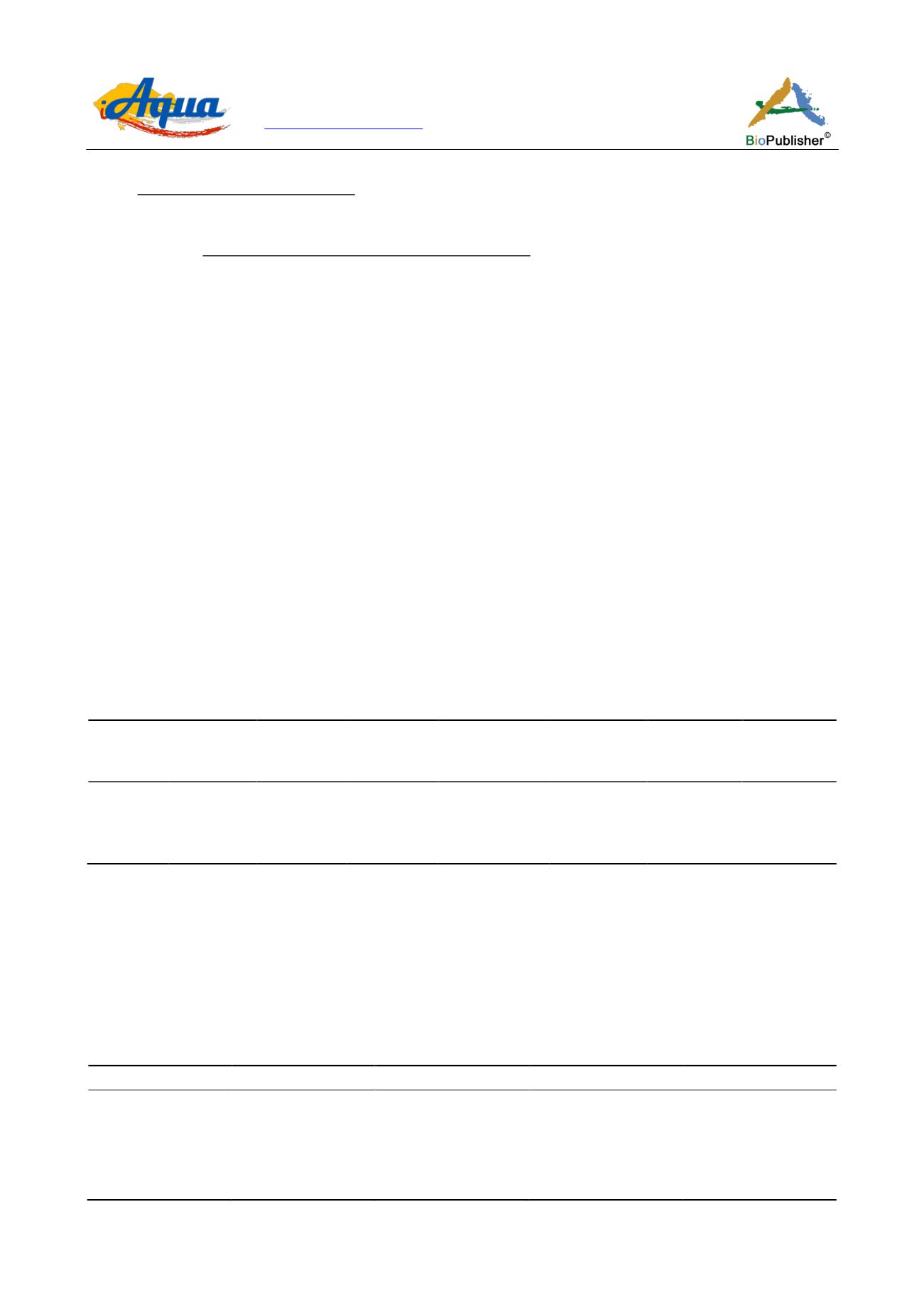
International Journal of Aquaculture, 2018, Vol.8, No.18, 137-144
139
FCR =
Quantity of feed distributed (g)
weight gain (g)
DWG (g/day) =
final mean weight (g) − initial mean weight (g)
experiment duration (days)
1.2 Statistical analysis
Data collected were encoded in Microsoft Excel 2013. They served to calculate zootechnical parameters. For each
parameter, mean and range were calculated. Mean data for each replication were considered as an observation.
The statistical software R (version 3.4.2) was used for analyses with 5% probability significance threshold. A one
way analysis of variance (ANOVA 1) was carried out in order to compare zootechnical parameters in the different
treatments. The Student-Newman-Keuls test (SNK test) served to carry out pair comparisons of the different
treatments when significant differences were observed among treatments to determine the optimal density, growth
and survival rate of
H. occipitalis
tadpoles.
2 Results
Table 2 shows the water physico-chemical parameters such as temperature, pH, dissolved oxygen, conductivity,
nitrites (N-NO
2
), nitrates (N-NO
3
) and ammoniac (N-NH
3
). During the experiment period, there was no
significant difference (
p
>0.05) among temperature, pH and conductivity. The highest values of these latter were
respectively 30.70°C (D
3
), 6.4 (D
1
) and 688.4 µs/cm (D
4
) while the lowest 25.22°C (D
2
), 5.2 (D
4
) and 410.6
µs/cm (D
2
). Concerning nitrites and nitrates, significant differences (
p
˂0.05) were observed among D
1
and D
3
, D
4
.
In contrary, there was no significant difference (
p
>0.05) among D
2
, D
3
and D
4
. Concerning total Ammoniac,
significant differences were observed (
p
˂0.05) among D
4
and D
1
, D
2
, D
3
.
Table 2 Mean ± range of temperature, pH, dissolved oxygen (DO), conductivity, nitrates, nitritres and ammoniac in ponds water
during the rearing period with the different stocking densities
Stocking
density
(Tadpole/L)
Temperature
(°C)
pH
DO (mg/L)
Conductivity
(µs/cm)
Nitrate (mg/L)
Nitrite (mg/L)
Ammoniac
(mg/L)
D
1
26.62±1.20
a
7.646±0.385
a
4.613±0.085
a
607.413±10.685
a
2.233±0.152
c
0.042±0.012
a
0.745±0.035
a
D
2
26.25±1.01
a
7.600±0.200
a
3.530±0.070
a
553.913±98.585
a
2.356±0.032
c
0.088±0.026
ab
1.45±0.250
a
D
3
26.57±1.03
a
5.600±0.200
b
2.333±0.173
b
574.560±83.100
a
3.076±0.025
b
0.054±0.025
b
1.555±0.085
a
D
4
26.46±0.87
a
5.650±0.250
b
1.886±0.309
c
588.663±95.135
a
3.560±0.036
a
0.038±0.002
b
1.680±0.230
b
Note:
abc
mean values on the same line and not affected by the same letter are significantly different (
p
<0.05)
Growth performances, stocking densities and survival rate of
H. occipitalis
tadpoles are mentioned in Table 3.
Final biomass, specific growth rate, food conversion rate and daily weight gain were considerably influenced by
the stocking density (Table 3). The increase of individual number in ponds led to a decrease of tadpoles’ growth
performance. The maximal mean value of final biomass was observed in density D
1
(5 tadpoles/L) either 23.750 ±
0.871 g. The lowest mean value was recorded in D
4
(20 tadpoles/L).
Table 3 Mean ± range of Initial Biomass (IB), Final Biomass (FB), Specific Growth Rate (SGR), Food Conversion Rate (FCR),
Survival Rate (SR) and Daily Weight Gain (DWG) of
Hoplobatrachus occipitalis
tadpoles reared at different stocking density
Paramètres
D
1
(5 tadpoles/L)
D
2
(10 tadpoles/L)
D
3
(15 tadpoles/L)
D
4
(20 tadpoles/L)
IB
7.483 ±0.386
d
16.450 ±0.026
c
25.356 ±0.621
b
39.570 ±0.320
a
FB
23.750 ±0.601
a
15.93 ±0.113
b
15.970 ±0.762
b
9.386 ±0.240
c
SGR (%/day)
4.220 ±0.255
a
1.960 ±0.326
b
2.251 ±0.431
b
3.683 ±0.561
a
FCR
1.436 ±0.023
c
1.810 ±0.075
b
2.185 ±0.218
a
2.176 ±0.058
a
Sr (%)
86.333 ±3.333
a
66.777 ±0.962
b
38.333 ±1.111
c
30.388 ±1.734
d
dwg (g/day)
0.735 ±0.026
a
0.254 ±0.018
b
0.270 ±0.071
b
0.022 ±0.021
c
Note:
abc
mean values on the same line and not affected by the same letter are significantly different (
p
<0.05)


